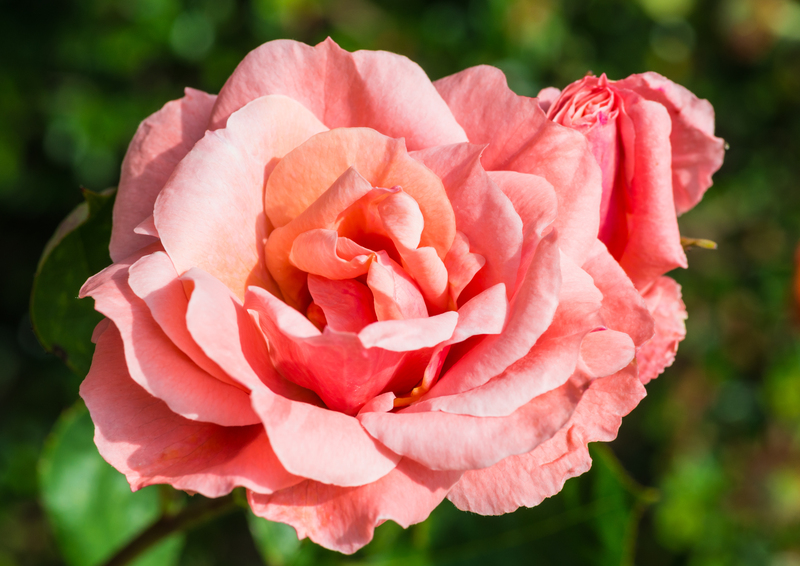Elevate Your Gardening: Effective Strategies for Weed Control
Posted on 01/06/2025
Elevate Your Gardening: Effective Strategies for Weed Control
Gardening is more than just planting and caring for beautiful plants; it involves persistent efforts to maintain a healthy, weed-free environment. Weeds are an inevitable aspect of gardening, often competing with your cherished plants for nutrients, water, and sunlight. This article delves into the most effective strategies for weed control and provides gardeners of all levels the knowledge they need to cultivate a lush, thriving landscape. Read on to explore practical, proven, and sustainable solutions for weed management in your garden.
Understanding the Impact of Weeds in Your Garden
Weeds are more than just unsightly additions to your garden. They can:
- Compete with your plants for essential nutrients, sunlight, and water.
- Attract pests and harbor diseases that can harm your garden's overall health.
- Crowd out desirable plant species, reducing biodiversity and aesthetic value.
- Spread rapidly and become increasingly difficult to eradicate over time.
To maintain a flourishing garden, it's crucial to employ effective weed management techniques. Let's explore the best methods to elevate your weed control efforts.

Types of Weeds: What Are You Up Against?
Before diving into control strategies, it's essential to recognize the different types of weeds you may encounter:
- Annuals: Sprout, grow, flower, and set seed all in one season. Examples include chickweed and crabgrass.
- Biennials: Complete their life cycle in two years, like Queen Anne's lace.
- Perennials: Live for more than two years, often returning stronger each season, such as dandelions and bindweed.
Knowing your enemy is the first step toward long-term weed control success.
Comprehensive Strategies for Weed Control
1. Preventative Weed Management
The most effective form of weed control begins before weeds even emerge. Here are some proactive techniques:
- Mulching: A thick layer of organic mulch (such as wood chips, straw, or bark) suppresses weed growth by blocking light and making it difficult for seeds to germinate.
- Landscape Fabric: Placing a weed barrier fabric under your mulch offers an extra line of defense against persistent species.
- Healthy Soil: Well-amended, fertile soil promotes robust plant growth, which in turn can outcompete invasive weeds.
- Dense Planting: Maximize the use of garden space to shade out weeds. Closely spaced plants limit the open soil where weeds can take root.
- Seed Selection: Use certified weed-free seeds and planting materials to minimize introducing new weeds into your garden.
2. Physical Weed Control Methods
Manual removal is one of the oldest and most effective strategies for weed management. Some tips include:
- Hand Pulling: Best suited for small garden spaces and young weeds -- ensure you remove the root system to prevent regrowth.
- Hoeing and Cultivation: Use a sharp hoe to sever weeds just below the soil surface. This works well for annual weeds before they set seed.
- Root Extraction: In the case of deep-rooted perennials, tools like dandelion diggers are helpful to extract the entire taproot.
- Solarization: Covering soil with clear plastic sheets in the heat of summer can kill weed seeds and roots through solar heat.
Physical weed control methods are low-cost, safe, and environmentally friendly. They also offer the added benefit of getting you more involved in your garden.
3. Organic and Natural Weed Control Options
If you prefer natural solutions, there are several organic approaches to keeping your garden weed-free:
- Mulching with Organic Materials: Besides traditional mulches, materials like newspaper and cardboard can be layered beneath mulch to smother weeds.
- Vinegar-Based Solutions: Household vinegar sprayed directly on young weeds can act as a contact herbicide, though it's less effective on established weeds.
- Boiling Water: Pouring boiling water over weeds is a simple method for patios and paths.
- Corn Gluten Meal: Acts as a natural pre-emergent herbicide, inhibiting seed germination (best for established gardens, not for new plantings).
Remember: Organic weed control may require repeated application and is often most effective when integrated with other methods.
4. Targeted Chemical Weed Control
For severe weed infestations, herbicides can be a tool for gardeners, but they require careful consideration and application. Here are some guidelines:
- Selective Herbicides: Target specific weeds without harming desired plants. Ideal for lawns, where killing broadleaf weeds but preserving grass is necessary.
- Non-Selective Herbicides: Kill any plant material they contact. Useful for driveways, walkways, or before starting a new garden bed.
- Spot-Treatment: Apply herbicide only to targeted weeds to minimize chemical use and environmental impact.
- Safety Measures: Always follow package instructions, use personal protective equipment, and be mindful of children and pets.
Chemical weed control should be integrated thoughtfully to balance effectiveness with environmental stewardship.
5. Integrated Weed Management (IWM)
For optimal results, many experienced gardeners advocate Integrated Weed Management, a combination of mechanical, biological, cultural, and chemical controls tailored to your garden's needs. IWM encourages:
- Monitoring: Regularly inspect your garden to identify weed issues early.
- Diversity: Rotate crops, use a blend of weed control methods, and foster a diverse plant ecosystem.
- Flexibility: Adjust your strategies based on seasonal factors, weed populations, and garden design.
IWM emphasizes prevention, early action, and comprehensive management for long-lasting weed suppression.
Pro Tips to Prevent Future Weed Problems
Preventing weed infestations is just as crucial as removing existing weeds. Here are some advanced, garden-saving tips:
- Don't Disturb Dormant Seeds: When digging or cultivating, only disturb soil if needed. Exposed seeds quickly germinate when brought to the surface.
- Edge Your Beds: Create clear boundaries between garden beds and lawns or wild areas to minimize weed encroachment.
- Clean Tools and Equipment: Always rinse tools after working in weed-infested areas to avoid spreading seeds.
- Use Drip Irrigation: Target water delivery to your plants, not the surrounding soil, to reduce weed seed germination.
- Promote Healthy Turf: In lawns, mow at the recommended height and avoid over-fertilizing to promote thick, healthy growth that shades out weeds.
Spotlight on Mulching: Your Weed-Free Garden Ally
Mulching deserves special mention due to its powerful effect on weed control. Here's why it's so effective:
- Blocks Sunlight: Prevents weed seeds from sprouting beneath its protective cover.
- Moisture Retention: Keeps your plants hydrated, improving their ability to outcompete weeds.
- Soil Health: Organic mulches break down over time, enriching your soil.
- Temperature Regulation: Maintains steady soil temperature, which benefits plant roots and hinders some weed species.
For best results, apply 2-4 inches of mulch, replenishing it as necessary and keeping it from directly contacting plant stems.
The Role of Cover Crops in Weed Suppression
Cover crops aren't just for farms -- they're fantastic for home gardens too!
- Living Mulch: Fast-growing plants like clover or rye provide ground cover, shading out weeds.
- Soil Improvement: Many cover crops fix nitrogen, break up compacted soil, or add organic matter when turned in.
- Between Seasons: Sow cover crops during fallow periods to discourage winter weeds.
Choose cover crops that suit your climate and gardening goals for an eco-friendly weed guarding strategy.
Timing Is Everything: When to Tackle Weeds
Weed control success depends heavily on timing:
- Early Spring: Remove young weeds before they set seeds.
- After Rain: Wet soil makes weed removal easier -- roots slide out with less resistance.
- Right Before Planting: Clear beds thoroughly to give new plants a head start.
- Avoid Letting Weeds Flower: Removing them before they set seed prevents next year's infestation.
Consistent maintenance keeps weed populations manageable and protects your investment in time and resources.
Common Weed Control Mistakes to Avoid
Even experienced gardeners can fall into these common weed control traps. Avoiding these mistakes will make your weed management more efficient:
- Ignoring Small Weeds: Little weeds quickly become big problems.
- Letting Weeds Go to Seed: Each mature weed can drop thousands of seeds.
- Over-Tilling: Constantly disturbing the soil can bring dormant weed seeds to the surface.
- Neglecting Garden Borders: Weeds at the edge can easily invade your cultivated beds.
- Misusing Herbicides: Incorrect application can harm desired plants or the environment.

Frequently Asked Questions About Weed Control
How can I control weeds without using chemicals?
Manual methods like hand-pulling, hoeing, and mulching are highly effective. Preventing weed growth by maintaining healthy, dense plantings and using barrier methods can minimize reliance on chemicals.
What is the best time of day to remove weeds?
Early morning or after rainfall, when the soil is moist, are the easiest times to pull or dig out weeds with intact root systems.
Will boiling water kill all types of weeds?
Boiling water is best suited for annual or small perennial weeds on hard surfaces like pathways. It may not kill deep-rooted perennials completely with a single application.
Is landscape fabric a long-term solution?
While weed barrier fabric can provide years of protection, it must be properly installed and maintained. Some persistent weeds can still penetrate or grow atop accumulated organic material over time.
Can I use mulch in all types of gardens?
Yes! Mulching around trees, shrubs, perennial borders, and even vegetable beds is highly effective, as long as you avoid piling it against stems or trunks.
Conclusion: Achieve a Weed-Free Garden for Good
Elevating your gardening game requires a thoughtful and consistent weed control approach. Whether you prefer organic measures, physical removal, or carefully selected chemical methods, integrating a variety of weed control strategies will help you maintain a beautiful, resilient, and productive garden.
Remember: The key to lasting weed management success lies in prevention, vigilance, and adaptability. By understanding weed biology, choosing the right tools, and adopting best practices, you can transform your gardening experience--and enjoy a lush, weed-free sanctuary year-round.
Ready to elevate your weed control strategy? Try integrating these techniques into your gardening routine, and watch your green space thrive!

